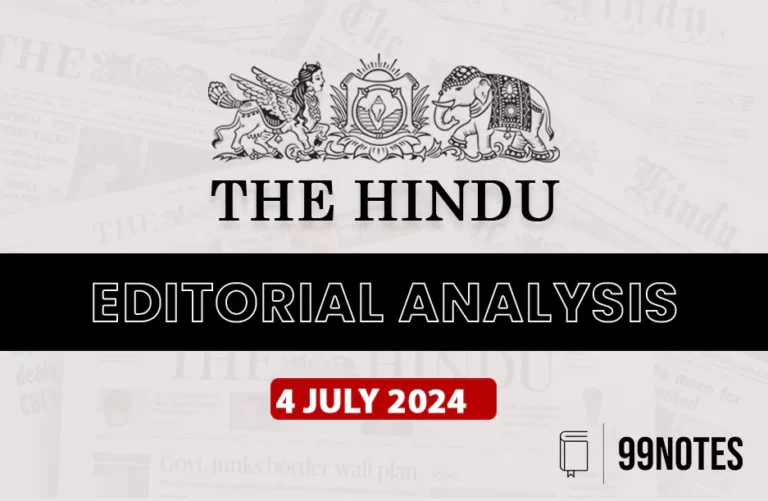12 June 2024 : The Hindu Editorial Analysis
1. India’s looming financial crisis
(Source – The Hindu, International Edition – Page No. – 8)
| Topic: GS3 – Indian Economy – Issues relating to development and employment |
| Context |
|
Introduction:
- Rapid credit growth is enticing, promising prosperity but often leading to economic crises.
- Financial booms are seen as innovative and beneficial, but often represent “irrational exuberance,” as noted by economist Robert Shiller.
- Economists Carmen Reinhart and Kenneth Rogoff highlight that past credit booms often lead to crises, dismissed by the belief that “this time is different.”
Current Scenario in India:
- India is experiencing a similar folly, with policymakers promoting a narrative of exceptional performance and prospects.
- The narrative touts India’s digital infrastructure as a driver of financial innovation and inclusion, promising growth and equality.
- This narrative has led to a poorly regulated financial sector and consumers living beyond their means, causing a surge in lending.
International and Domestic Praise:
- The International Monetary Fund (IMF) in December 2023 praised India’s financial sector for robust growth in bank lending and low non-performing assets.
- The National Council of Applied Economic Research in March 2024 noted a 20% increase in bank lending, particularly in personal loans, signaling bright prospects despite struggling industrial lending.
Underlying Issues:
- The focus on credit growth overlooks deeper issues such as jobs and human capital deficits.
- The financial sector appears healthy as long as new loans pay off old ones, but collapses when lending slows and repayment options diminish.
- The IMF notes that heavily indebted households and businesses reduce spending to repay debt, leading to an economic crunch.
Household Lending Surge:
- India faces a household lending boom, with lending expanding between 25% and 30% annually.
- Many lower- and middle-income households view loans as easy cash to meet ends or buy homes, gadgets, and other consumer goods.
- This surge in household lending does not add to productive capacity but increases domestic prices, reducing competitiveness.
Risks of Household Debt Boom:
- Economists Atif Mian and Amir Sufi argue that higher household debt burdens lead to steeper crashes.
- India shows key elements signalling a looming financial crisis: a stock market detached from weak corporate investment and consumer spending, an overvalued exchange rate, and questionable data from authorities.
- A financial crisis will cause economic pain and degrade long-term economic well-being.
Historical Context of Policy Failures:
- Three decades of economic and financial policy failures, not just the recent government, have led to this situation.
- Successive policymakers have relied on the financial services industry to boost headline GDP growth in the absence of job-rich manufacturing growth.
- The financial sector has contributed over a quarter of GDP growth in the last decade.
Chaotic Financial Services Industry:
- India’s liberalisation has led to a large and chaotic financial services industry with 30 major providers and thousands of smaller players.
- Many financial institutions have a history of rogue behaviour, leading to scams since the start of economic liberalisation in 1991.
- Post-COVID-19, financial services providers redirected lending toward households with stagnant incomes, led by new fintechs offering loans at high-interest rates.
Growing Household Debt and Risks:
- A significant share of household loans is unsecured, with credit card debt being a major concern.
- By January 2024, Indians owned almost 100 million credit cards, up from 20 million in 2011.
- Aggressive peddling of credit cards to low-creditworthy individuals builds stress for both borrowers and the financial system.
Paradox of Credit Growth and Consumption:
- Despite buoyant credit growth, household consumption is increasing slowly.
- Households are borrowing to boost meagre consumption as savings rates decline.
- Eventually, it will no longer be possible to repay old loans with new ones, leading to defaults and economic contraction.
Impending Crisis:
- The crisis will initially manifest through macroeconomic contraction, followed by loan defaults.
- Initial defaults will lead to cascading failures in the interconnected financial sector.
- The interconnected nature of banks, non-banking financial institutions, and fintechs will exacerbate economic contraction and financial distress.
Potential Solutions:
- To prevent the crisis, the financial services industry needs to be downsized to better match lending capacity and productive borrowing needs.
- Weakening the rupee could help expand exports and cushion the downturn.
- Policy change is unlikely due to a commitment to the notion that finance will spur growth and a strong exchange rate as a national strength indicator.
Conclusion:
- India’s credit-reliant economic strategy is heading towards a crisis without adequate checks.
- The nation’s financial and policy elite have adopted a see-no-evil attitude, overlooking the impending risks.
- The crisis will exacerbate economic inequalities and worsen the employment situation, impacting the weak and vulnerable the most.
| PYQ: Do you agree that the Indian economy has recently experienced a V-shaped recovery? Give reasons in support of your answer. (250 words/15m) (UPSC CSE (M) GS-3 2021) |
| Practice Question: Analyse the potential risks of rapid credit growth in India, considering historical parallels and the current economic context. Discuss the implications for household debt, financial stability, and long-term economic health. (250 Words /15 marks) |
2. Arrest, agencies, and criminal courts
(Source – The Hindu, International Edition – Page No. – 9)
| Topic: GS2 – Indian Polity – Judiciary |
| Context |
|
Supreme Court Judgments Impacting Liberty of Accused
- In May 2024, the Supreme Court of India delivered two significant judgments that affect the liberty of individuals accused of criminal offences.
- These judgments address the necessity of custody before filing charge sheets and the requirement to inform accused persons of the grounds of arrest in writing.
Custody Before Filing Charge Sheet
Background:
- In the 2021 case of Siddharth v. State of Uttar Pradesh and Another, the Supreme Court ruled that it is not necessary for an investigating officer (IO) to present an accused person in custody at the time of filing the charge sheet if the accused has been cooperating with the investigation.
Key Points:
- Section 170 of the Criminal Procedure Code (CrPC): The Court clarified that this section does not mandate the investigating officer (IO) to arrest every accused person when filing the charge sheet.
- Lower Court Compliance: Lower courts must accept charge sheets without the accused’s presence if they have been cooperative and are not a flight risk or likely to disobey summons.
- Challenges in Practice: Despite this ruling, IOs often face practical difficulties in filing charge sheets, particularly in cases involving multiple accused persons. Courts sometimes reject charge sheets if all accused are not present or impose arbitrary limits on the number of charge sheets accepted in a day.
Implications:
- Relief for Investigating Agencies: Proper compliance with this judgement would ease the burden on IOs and streamline the judicial process.
- Continued Challenges: The reluctance of IOs to raise these issues with Sessions Judges due to potential repercussions for other tasks remains a problem, suggesting the need for systemic reforms.
Grounds of Arrest
Article 22 of the Constitution:
- The fundamental right under Article 22 mandates that an accused person must be informed of the grounds of arrest.
Supreme Court Judgments:
- Pankaj Bansal v. Union of India and Others (2023): The Supreme Court emphasised that informing the accused of the grounds of arrest in writing is crucial to uphold constitutional and statutory rights.
- Prabir Purkayastha v. State (NCT of Delhi): This judgement reiterated the Bansal case’s principles, applying them equally to the Unlawful Activities (Prevention) Act (UAPA).
Section 50(1) of the CrPC:
- Provision Requirements: This section stipulates that any police officer or person making an arrest without a warrant must immediately communicate the full particulars of the offence or grounds of arrest to the arrested person.
- Implementation: Arrest memos prepared by IOs note that the arrested person has been informed of their arrest grounds and legal rights. These memos include details of the offences, dates, times, and are signed by both the IO and the arrestee. However, there is no legal provision for providing a copy of this memo to the arrested person, which is especially relevant for those not named in the First Information Report (FIR).
Implications:
- Legal Counsel and Bail: Providing written grounds of arrest enables the accused to seek legal counsel and apply for bail based on clear facts presented by the investigating agency.
- Consistency with Article 22: Extending the Bansal case principles to Section 50(1) of the CrPC aligns with the constitutional mandate, suggesting the need to amend the law to ensure the accused receive a copy of the arrest memo.
Practical and Legal Recommendations
Systemic Reform:
- Judicial Compliance: Ensuring lower courts strictly follow the Supreme Court’s directives can alleviate practical issues faced by investigating agencies.
- Legal Amendments: Amending laws to mandate the provision of arrest memos to accused persons would strengthen their constitutional rights and facilitate a fairer legal process.
Conclusion
- These Supreme Court judgments underscore the importance of procedural fairness and the protection of individual liberties in the criminal justice system.
- By addressing the necessity of custody before charge sheet filing and the requirement to inform accused persons of arrest grounds in writing, the Court aims to enhance the rights of the accused and ensure a more transparent and just legal process.
- However, the practical implementation of these judgments requires systemic reforms and possible legal amendments to fully realise their intended benefits.
| Practice Question: Discuss the implications of the Supreme Court’s May 2024 judgments on the custody of accused persons before filing charge sheets and the requirement to inform them of arrest grounds in writing. How do these rulings align with constitutional protections under Article 22? (250 Words /15 marks) |
3. The social sciences, a shelter for the ‘excluded’ student
(Source – The Hindu, International Edition – Page No. – 8)
| Topic: GS2 – Social Justice – Education |
| Context |
|
Introduction and Importance of Higher Education for India’s Youth
- The general election has just concluded, and many of India’s youth are now seeking college admissions, which are essential for realising the goal of a developed India by 2047.
- The month of May is particularly significant for these students, as examination results are released, leading to a scramble for higher education seats.
- This period marks a critical transition that influences the quality and quantity of human capital, which is vital for the country’s economic growth.
Challenges in Higher Education Transition
- Mismatch Between Demand and Supply: There is a significant disparity between the aspirations of students and the availability of courses and seats in higher education.
- Excess and Shortage: Some courses and institutions have an excess of seats, while others face a shortage, leading to a scenario where certain disciplines become the last resort for many students.
- Reservoir of the Excluded: Social sciences are becoming a large reservoir for students who are excluded from other disciplines due to various factors.
Causes of Demand-Supply Mismatch
- Incongruence of Aspirations and Availability: The mismatch arises from the gap between what students and parents aspire to and what is available, influenced by market forces in private institutions and government policies in public institutions.
- Types of Exclusions:
- Excessive Competition: Premier institutions have high competition due to limited seats and high prestige.
- Financial Factors: High fees in private institutions and increasing fees in public institutions due to reduced government funding lead to financial exclusion.
- Regional and Subject-Based Exclusions: Availability of courses and institutions is often region-specific, with some regions offering only generic and outdated courses.
- Persistent exclusions undermine the long-term quality of human capital, which is essential for economic growth and development.
Enrolment Trends and Statistics
- According to the 2021-22 All India Survey on Higher Education (AISHE):
- Undergraduate Enrolment Growth: 4.1% increase from 2017-18 to 2021-22.
- Postgraduate Enrolment Growth: 5.9% increase during the same period.
- Bachelor of Arts (BA) Programme: Registered a 15% increase in enrolment from 2017-18.
- Master of Arts (MA) Programme: Saw a 26.5% increase in enrolment from 2017-18 to 2021-22.
- Share of Enrolment:
- BA has 51% enrollment in regular mode and 75% in distance mode.
- MA has 12% enrollment in regular mode and 42% in distance mode.
- Implication: BA programmes serve as a generic pool accommodating many students excluded for various reasons.
Trends in Social Science Preferences
- Empirical Orientation: Courses with empirical orientation, such as economics, are preferred for their perceived higher employability compared to courses like anthropology or sociology.
- Policy Intervention Skills: There is an increasing emphasis on acquiring policy intervention skills, leading to narrower specialisations within social sciences.
- Private Universities: These institutions cater to affluent populations and offer courses in high demand, such as sociology and political science, which are less demanded in public institutions.
Improving Quality of Higher Education
- Need for Overhaul: Higher education in social sciences requires comprehensive reforms to improve both quantity and quality.
- Quality Enhancement: Focus on enhancing teaching quality and updating course content is essential.
- Addressing Financial Exclusion: Mitigating financial exclusion to reduce inequalities and avoid the creation of elite enclaves in education.
- Leveraging Demographic Dividend: Improving the quality of social science education is crucial for harnessing the potential of India’s youth, especially in an era of rapid technological advancements like generative artificial intelligence.
Conclusion
- Addressing the challenges in higher education transition and improving the quality of social sciences education is vital for India’s economic growth and development.
- Ensuring inclusive and equitable access to higher education will help in creating a skilled and competent workforce, contributing to the vision of a developed India by 2047.
| PYQ: The quality of higher education in India requires major improvements to make it internationally competitive. Do you think that the entry of foreign educational institutions would help improve the quality of higher and technical education in the country? Discuss. (200 words/12.5m) (UPSC CSE (M) GS-2 2015) |
| Practice Question: How do demand-supply mismatches, financial exclusions, and regional disparities impact the transition of Indian youth to higher education? Discuss the implications of these challenges for the quality of human capital and suggest reforms to address them. (150 Words /10 marks) |





